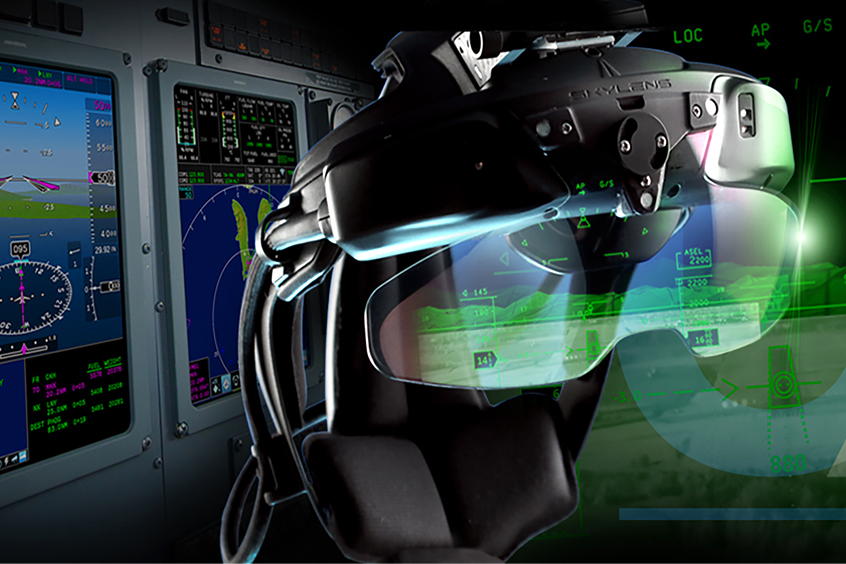ACE 2026 - The home of global charter.
 The bimonthly news publication for aviation professionals.
The bimonthly news publication for aviation professionals.

Universal Avionics (UA), an Elbit Systems company, showcased its Interactive-Synthetic Vision System (i-SVS) during the 2019 Paris Air Show. The operator's sight-control concept allows pilots to easily select entities on the company's conformal SkyLens head-wearable display (HWD), sending it directly to the InSight display system.
SkyLens and InSight are both said to be critical components for safety in today's aircraft and reliance on them by the operator varies during the phases of flight. Integrating the two technologies enables the pilot to have the key information required, right when it's needed and presented super-positioned on the real world. Pilots can control the InSight display system by a 'look and select' menu system displayed via the SkyLens HWD with an unlimited field of view. Sight-selection reduces operational tasks, allowing the pilot to programme and update flight path, runway selection and other commands during critical approach phases, without distracting attention from flying the aircraft head-up. The fully integrated i-SVS function allows change of runway selected, approach selected and waypoint programming, all by looking on a virtually presented flight path and point selection with sight.
“Integrating the SkyLens HWD with the InSight display system offers a next generation cockpit, providing the ultimate presentation of essential flight data precisely when pilots need it most,” explains CEO Dror Yahav. “The i-SVS provides an enhanced, more intuitive user interface, allowing pilots to 'fly-by-sight'; simply look, point and click. The integration also allows for improved performance with a significant reduction of workload and a new level of safety and operational effectiveness. It's the first step to support single pilot operation.”
As part of the nextgen roadmap, the InSight/SkyLens integration aligns with Federal Aviation Regulation 91.176 released by the FAA, enabling the operator to perform a full landing procedure with no natural vision, where the reported visibility is as low as 1,000 ft. The integrated system offers unmatched capabilities, providing dispatch and landing approach priority as well as low visibility landing regardless of the destination airport's infrastructure. Once on the ground, SkyLens can assist and guide the aircraft to the gate in poor conditions.
UA has also launched its next generation of Flight Management System (FMS), the ClearVision Interactive-FMS (i-FMS), a software-based FMS designed to be an end-supplier solution for flight management in an integrated modular avionics infrastructure. The i-FMS offers the latest in human-machine interface (HMI) by augmenting head-up displays (HUD) and HWD to the flight deck itself, allowing pilots to fly-by-sight. Certification is expected during the second half of 2020.
Built from the ground-up, the i-FMS tackles one of the main challenges pilots face today with FMS operations; the need to propose changes to the FMS during critical phases of flight such as takeoff and landing. Typically, during this time pilots are required to shift their attention from outside the cockpit window to the FMS display unit, to reprogramme the FMS and validate changes are correct, requiring last-minute updates and head-down operations. The i-FMS better supports this, allowing pilots to project waypoints and information from the FMS onto the real-world, superimposed on a HUD or UA's SkyLens HWD. Pilots are able to interact with these features by line-of-sight (head/eye tracking) and a select/deselect button on the aircraft yoke or throttle.
“Market trends are moving in the direction of software-based FMS rather than hardware, as they offer users a more flexible and open architecture system,” explains Yahav. “The i-FMS software can run on a variety of hardware options, for commercial or paramilitary applications. New, innovative interfaces, augmented to the real world utilising HUD technology is where we believe the market is heading. It's the future of flying and we're seeing a high level of interest in it. What really distinguishes our i-FMS solution is that we designed it to support flying by sight. It will simplify avionics and eliminate many of the current pain points in pilot interfaces.”
The i-FMS features a portable FMS with highly modular architecture for ready deployment to any ARINC 653 compliant platform and a separate HMI. The ARINC 653 compliant system allows customers to run the application in many third-party options to best suit their flight deck, with no need for specific hardware or line replaceable units. The HMI, implemented with an ARINC 661 user application, connects to the core operating system and allows pilots to communicate with the application. With UA's easy-to-use, customisable HMI customers can design their own flight deck with the hosted FMS software. Since the system is modular, customers may specify future functionalities, allowing for easy adaptation to address upcoming requirements. Support for a third-party HMI is also offered. Additionally, customers may integrate their proprietary functions by interfacing to the core operating system or by customising menus and operational logic.